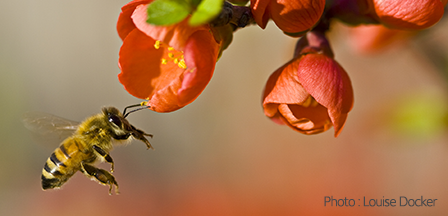Published on

You probably know that bees across North America are in crisis. A big part of the problem are a group of pesticides known as neonics (short for neonicotinoids). Fortunately, government regulators are taking action – in Ontario with stricter rules for neonicuse and federally with a recent verdict by Health Canada. The federal department found that imidacloprid, one of the most widespread neonics, is unacceptably dangerous to aquatic wildlife and will consequently be banned from use on our farms and fields. Let’s take a closer look.
What is Imidacloprid?
Imidacloprid, like all neonics, is an insecticide that kills pests by attacking their nervous system. It is a systemic pesticide, which means that whether it is applied on seeds or leaves it spreads through the entirety of the plant. Imidacloprid was the first neonic to be discovered and introduced in Canada during the 1990s as a promising alternative to harmful older-generation pesticides. Data from Ontario show that, along with other neonics, imidacloprid coats almost 100 per cent of corn seeds and over half of soybean seeds, and is often used in grape farms, greenhouse farming, on urban trees and for pets.
A False Promise
For many years, experts and researchers have pointed to the potential harms of imidacloprid and other neonics to important insects such as bees and called for restrictions on their use in agriculture. Recent research has demonstrated that neonics impair the learning, memory communication, reproductive health and foraging behaviour of bees and other pollinators. This is a major problem as these pollinators are responsible for pollinating the vast majority of our food crops.
Imidacloprid persists in the environment for a very long time, is water soluble, and may affect field crops for several consecutive growing seasons. Once in the environment, it can move through soil or water, and can contaminate waterways and aquatic wildlife.
Government and academic data show that fresh water sources in southern Ontario and wetlands near agricultural areas in Saskatchewan are heavily contaminated with imidacloprid, and in many instances, at levels that exceed federal guidelines.
Despite mounting scientific evidence highlighting the negative effects of neonics, Health Canada released an assessment in 2016 concluding that neonics do not pose a major threat to bees. This stands in stark contrast to a growing body of international scientific research. Some provincial and municipal governments like Ontario and Montreal, however, decided to move forward on restrictions on neonics to protect pollinators.
New Evidence Prompts Health Canada Ban
Last November, Health Canada’s Pesticides Management Regulatory Agency published its reevaluation on imidacloprid concluded that the pesticide is highly toxic to beneficial aquatic insects such as mayflies. Based on these findings, Health Canada has proposed to gradually ban imidacloprid for major agricultural uses as well as other outdoor uses of this pesticide, in the next three to five years.
This is great news for both pollinators and aquatic insects across Canada! However, we need to see a shorter timeline for the ban and federal bans on other harmful neonic pesticides. With imidacloprid being phased out, we could see a rise in the use of other neonics like clothianidin and thiamethoxam. Both of these have also been linked to detrimental effects in bees.
Health Canada will conduct special reviews on these two neonics over the next two years. Équiterre along with other environmental and health groups will be watching closely. Together, we will continue to work with the federal government to ensure restrictions on harmful neonics are implemented quickly.
We will continue to require that the federal government protect human health and the environment by revising legislation governing consumer products and pesticides in Canada.
Adapted from a blog by Muhannad Malas, Program Manager, Toxic, Environmental Defence, January 6th, 2017.




